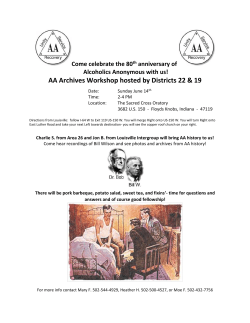
DIGITIZATION OF THE MILITARY ARCHIVE OF SERBIA
DIGITIZATION OF THE MILITARY ARCHIVE OF SERBIA INFORMATION IS THE CURRENCY OF DEMOCRACY OR DIGITIZATION AS A DEMOCRATIZATION TOOL Our experience The Jefferson Institute brings a wealth of experience and technological capacity to this essential task for the conscientious and forward-thinking archivist. Since 2006, we have digitized an average of 100,000 pages of archival material each month. This effort has converted materials spanning more than three centuries into a web-ready and easily-searchable form. Military Archive of Serbia Archive of Bosnia and Herzegovina Introduction Military Archive of Serbia Archival material is systematically preserved from 1847. Prince Milos Obrenovic IV establishes the General staff of the Serbian Army, including one department with the goal to collect historical data and documents, write military history, and manage the General Staff library. Notable Holdings of Military Archive In Serbia, a young democracy emerging from decades of despotic rule, military records were off limits, obscuring a history clouded by military abuses. 2006 A pilot project "Digitization of the Serbia Military Archive" is launched, with the support of the Knight Foundation, the Rockefeller Brothers Fund and the Canadian government. 2007 Full production of the digitization effort starts with the support of the Norwegian government. 2008 A Photo center is added to the Military Archive digitization project 2008 Jefferson Institute merged digitally born database of photos (after 2000) and negatives 1945-2000 and made them equally accessible and searchable. 2010 Jefferson Institute's Serbia Military Archive digitization project ends: 4 million documents digitized or 9% of total Ministry of Defense archival holdings. Digitization continues under the leadership of the Military Archive. 2011+ With open public keyword search, citizens have easy access to thousands of documents a day - gaining knowledge of their past, understanding of their present, and the power to build a better future. Hardware Two Biggest Investments: 1. Security Hardware Two Biggest Investments: 2. Backup System Software Archive Digitization Application (ADA) is a management system tool which integrates digitization and research processes for small and medium archives. The tool is designed to integrate both the production and research level, so archives can model, control and monitor their digitization projects and research. About ADA Modular structure and clear organization with two major levels: Production level • User friendly (metadata import, scanning, controlling) • Central administration (process control and statistical analysis) • Flexible structure (sequencing the workflow becomes less important) • Link to OCR engine Research and presentation level • Full text search • Easy link to other available open source presentations • Access control and evaluation Value added • Minimum input to individually tailor your digitization project • In-house control of the whole process • Full and instant access to research results • Uses Java servlets and JSP technology • Easy link to other Open Source presentation platforms • As a server application, assures security of the holdings and their digital presentation Full control How does it work? Production level You can scan, enter metadata, quality check and rescan simultaneously. It is highly flexible. Sequencing the workflow becomes less important. Instantly leading you to an EXCITING RESEARCH LEVEL with intuitive research interface: … and the research MEAT: Document interface As a researcher you can ALSO: Tag and annotate documents That data (with archivists authorization) is fed back to the central repository of metadata that all users search against. Date is wrong here! Annotation is a tradition among users of archives – they write notes on the folders for the next researchers to come – and ADA seamlessly pulls that tradition into the digital age. Presentation Monticello dinners timeline Archivists can take quick action to leverage opportunities, build special exhibits of high interest collections. Mr. Jefferson’s life timeline Our current project Goals Engage communities across USA starting with: •Digitization of the Macon collections •Share the solution with Baltimore City Archive How we are going to achieve this? • Enhancing ADA to an open source tool for small and medium archives • Establishing partnership between local, state and federal intuitions • Mobile and education as two main pillars Our goal Archives Distance learning Community portals & www.archivedigitization.org
© Copyright 2025



















